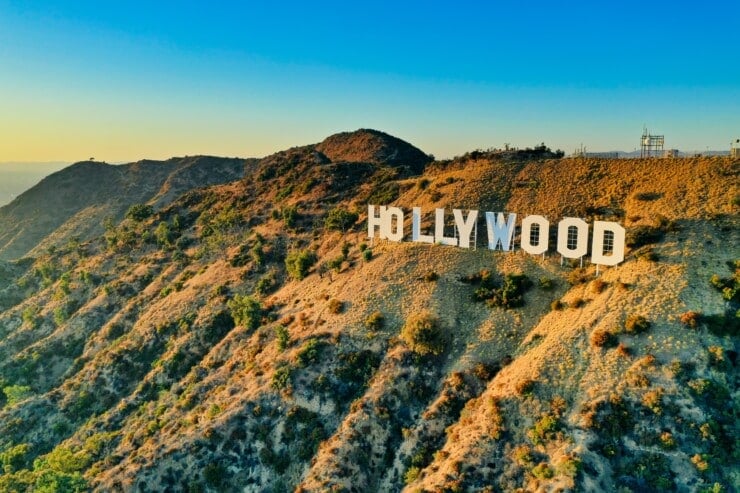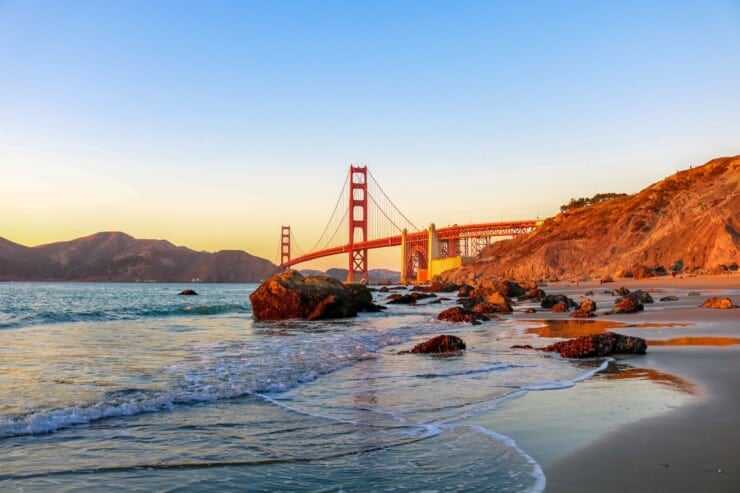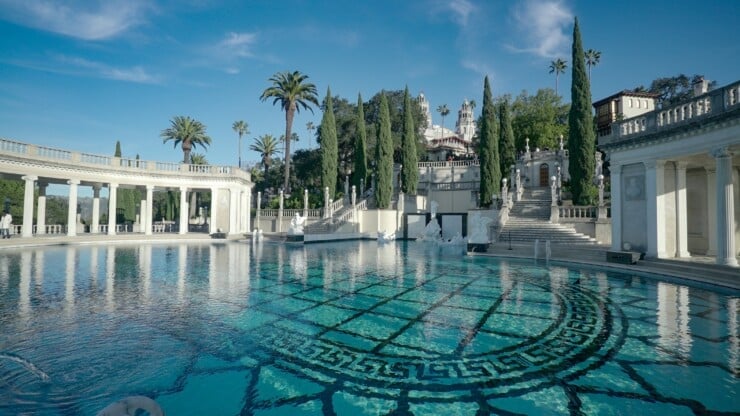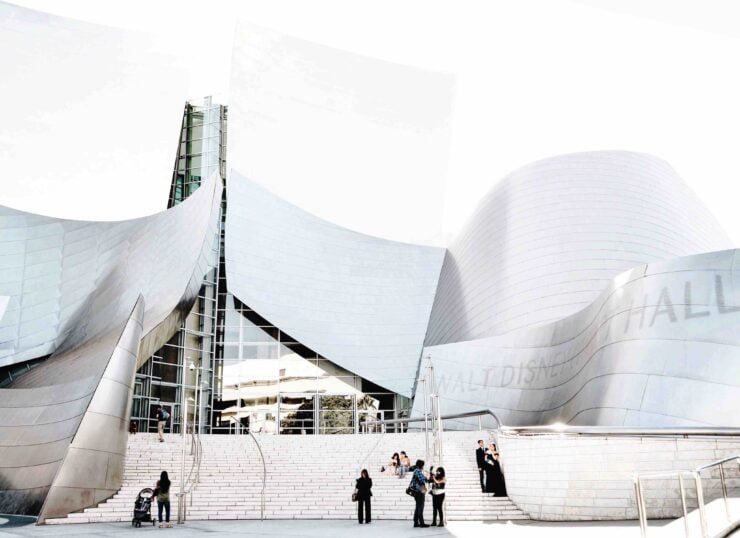Table of Contents
We’re all about farm-to-table food and quality goods from the local community wherever we travel, and in California, that also extends to the state’s impressive architecture.
The state may be one of the youngest in the nation, but, despite its relatively short history famous buildings in California and leading examples of global design are plentiful.
We’re talking more than historical landmarks and some of the most famous sights in the United States, like TCL Chinese Theatre, the Hollywood Walk of Fame, Griffith Observatory, and the Transamerica Pyramid.

15 Famous Buildings In California Worth A Visit
Here we’re diving into California’s top architecture up and down the state, from Victorian mansions to swoony mid century modern buildings and everything in between. Let’s start from the northernmost regions and work our way down to southern California.
Consider this list a tribute to some of California’s most historical and most iconic buildings featuring top-notch design.
Northern California
Carson Mansion, Eureka, Humboldt County
Eureka is a small northern California city surrounded by National and State Parks (aka redwoods for days.) It also offers one of the most well-preserved and most photographed examples of ornate Queen Anne-style architecture in California.
Since the Carson Mansion today is owned by a private club, it’s closed for tours, but it’s possible to snag a photo of its impeccable exterior from the sidewalk. You’ll notice many details, including towers, turrets, and columned porches. It was originally built in 1889 for lumber proprietor William Carson and constructed primarily from local redwood and white mahogany from Central America.
Carson Mansion, 143 M St, Eureka, CA 95501
Governor’s Mansion, Sacramento, Sacramento County
Maybe you’re heading on a classic California road trip along Highway 395 (which connects Lake Tahoe, Las Vegas, and Reno) [SWT: Add links]. If you’re also into Victorian architecture, stop in Sacramento to check out the Governor’s Mansion.
The historic building was constructed in 1877 for a co-owner of a hardware store and changed hands a few times before the State bought it in 1903. And even though open floor plans are the “it” style these days, the mansion’s various rooms are very 19th-century. Think of multiple parlors like a formal and less-formal room, a music room, a dining room, a breakfast room, and more.
It’s the first official residence for the state’s first families. Although it’s unoccupied at the moment, the mansion has served as a home to multiple California governors, including Ronald Reagan, who would become a U.S. President.
Governor’s Mansion, 1526 H St, Sacramento, CA 95814
Gunther’s Ice Cream Shop, Sacramento, Sacramento County
Another architectural find in Sacramento launches us out of the Victorian era and into the mid-century “Googie style.” Yes, “googie” is an actual term for the style that originated in southern California, and dramatic neon signage, upswept roofs, and futuristic, space-age details characterize it.
Gunther’s Ice Cream Shop was built in 1948 in this style. Its large, angled glass window panels and major neon signage of ‘Jugglin’ Joe’ tossing an ice cream scoop into a cone is a visual exterior treat before heading inside for something sweet—slow-churned ice cream in classic flavors like chocolate and butter pecan.
Gunther’s Ice Cream Shop, 2801 Franklin Blvd, Sacramento, CA 95818

San Francisco Bay Area
Sea Ranch, Sonoma County
Sea Ranch is a master-planned community developed by architect and planner Al Boeke with the idea that the structures would harmoniously coexist with Sonoma Coast’s rugged landscape—and a part of the NorCal coast many non-Californians tend to skip over. The design goal was to have an as little man-made impact on the natural environment as possible.
High ceilings, lots of local Douglas fir and redwood, natural-looking stains and finishes, and angled roofs with no overhang meant to move with the wind rather than against it all come together in a defining style of the early 1960s. So much so that it set the tone for design trends in the decades after, like those wood-paneled rooms everywhere in the 1970s.
In 2005, the project’s Condominium #1 was listed as part of the National Register of Historic Places for its influence on American design and architecture.
Golden Gate Bridge, San Francisco Bay Area, San Francisco County
There’s a reason why the Golden Gate Bridge was an instant California tourist attraction when it was constructed in 1937. Engineer Joseph Strauss and his team dreamed up its look and felt, including its Art Deco towers and famous rust color referred to as “International Orange.” Its distinct color blends with the natural scenery and is visible enough to ships in San Francisco’s inevitable fog.
The suspension bridge is nearly two miles long, includes a pedestrian walkway, and connects San Francisco to Marin and Napa Counties. In 1994 the American Society of Civil Engineers declared it one of the seven civil engineering wonders of the world, alongside Italy’s Tower of Pisa and Paris’ Eiffel Tower. It’s considered one of the most photographed bridges in the world and a must-see on every San Francisco itinerary as arguably one of the most famous landmarks in the country.
Weston Haven House, Berkeley, Alameda County
This impressive residence was home to a prominent real estate developer’s son, John Weston Havens, Jr., who at the time was enamored with the look and feel of famous architect Frank Lloyd Wright’s Usonian style. Usonian is a term Wright coined during his day and generally captures signature elements like low-slung roofs, open spaces, and built-in furnishings.
Architect Harwell Hamilton Harris designed the house in 1940 to maximize the views with its location perched atop Panoramic Hill in Berkeley near UC Berkeley’s campus. That meant ceilings tipped upward and panoramic glass windows that overlooked San Francisco Bay.
Weston Havens House, 255 Panoramic Way, Berkeley, CA 94704

Central Coast
Clinton Walker House, Carmel-by-the-Sea, Monterey County
Speaking of Frank Lloyd Wright, Clinton Walker House is widely considered one of the most famous of the 300-odd private residences he designed. Since it is someone’s home, public tours of its interior aren’t a thing, but you can admire Wright’s work from the shoreline.
This small, triangular-shaped stone house was built in 1948 for Mrs. Clinton Walker. It has a low profile that looks out over the water in Carmel and features horizontal windows wrapped in red steel and bluish roof shingles to mimic the sky. It’s one of the few residences Wright designed in a coastal environment.
Clinton-Walker House, 26336 Scenic Rd, Carmel-By-The-Sea, CA 93923
Nepenthe, Big Sur, Monterey County
Students of architect Frank Lloyd Wright have garnered recognition for their works over the years, like Nepenthe off California Highway 1 in Big Sur.
Designed by architect Rowan Maiden, Nepenthe is a restaurant that serves double duty as a food stop with gorgeous views of Graves Canyon, the iconic Pacific coastline, and Maiden’s organic, modern style. Redwood and adobe materials are prominent throughout, for example.
Its former lives include being the private retreat for Hollywood actors Orson Welles and Rita , and before that, it belonged to the Trail Club of Jolon.
Nepenthe, 48510 CA-1, Big Sur, CA 93920
Hearst Castle, San Simeon, San Luis Obispo County
California is so young compared to other parts of the world that it’s especially striking to see an Old World-type structure like a castle looming around these parts.
As such, Hearst Castle in San Simeon, which began construction in 1919 and lasted through the late 1940s, is worth a tour. It’s named after William Randolph Hearst, an American entrepreneur who owned newspapers, made films and served in Congress. The castles he saw in Europe as a child inspired the castle.
The main residence of the 127-acre estate gives a Mediterranean Revival style, with bell towers and decorative touches that would be considered “extra” in our modern, more clean-lined design preferences these days. The estate also has an indoor pool inspired by ancient Roman baths and an outdoor pool with a waterfall feature. Today the estate is a State Park.
Julia Morgan led the estate’s design and was one of the few female architects of her time as the first woman to graduate from Ecole des Beaux-Arts’s architecture program in Paris.
Hearst Castle, 750 Hearst Castle Rd, San Simeon, CA 93452

Southern California
Walt Disney Concert Hall, Downtown Los Angeles, Los Angeles County
The Walt Disney Concert Hall in Downtown Los Angeles (completed in 2003) spans a whole city block. You might recognize it from its curvy steel facade and glass paneling that invites light into its lobby and pre-concert room.
If you’ve been, it might look like something you’ve seen in northern Spain, like the Guggenheim Museum in Bilbao. [SWT: Add links] You’d be correct as renowned architect Frank Gehry—a student of William L. Pereira, but more on him below—designed both.
Many in the design world associate the Concert Hall with the 1980s deconstructivist movement characterized by asymmetry and may seem more visually disorienting than other styles.
Walt Disney Concert Hall, 111 S. Grand Ave., Los Angeles, CA 90012
Hollyhock House, Los Angeles, Los Angeles County
Hollyhock Hous is named after the flower favorite of Frank Lloyd Wright’s client, oil heiress Aline Barnsdall.
In the early 1920s, Barnsdall commissioned Wright to design an arts complex in Los Angeles. Though the complex was never completed, there is a residence and two apartments. They are early examples of Mayan Revival architecture and one of Wright’s earliest designs in this style. Mexico’s pre-Columbian temples inspired this style, becoming popular in the 1920s and 30s.
The upper level of the house’s exterior, windows, and furniture all display hollyhock décor. The house is situated around a courtyard, and a circular pool and its rooftop terraces offer views of the Hollywood Hills. A Hollyhock-decorated fireplace anchors the spacious house’s 17 rooms and seven bathrooms, with a skylight above it and a moat below.
Hollyhock House is part of Barnsdall Art Park, and it was Wright’s first design project in Los Angeles. Also nearby is the Mayan-influenced Sowden House, a 6,000-square-foot mansion designed by Wright’s son.
Hollyhock House, 4800 Hollywood Blvd., Los Angeles, CA 90027
Anaheim Regional Transportation Intermodal Center (ARTIC), Anaheim, Orange County
For a modern and eco-friendly take on the country’s early 20th-century transit halls like Penn Station in NYC, the Anaheim Regional Transportation Intermodal Center (aka ARTIC) in Orange County is a stunning example. It opened for service in 2014 and is the hub for Amtrak’s Pacific Surfliner line—it runs up and down the coast, btw—and more.
Its most dramatic feature is its soaring, curved glass atrium, inviting in all-natural light. There are also distant views of the Santa Ana Mountains. Entering the transportation center means passing through a wide plaza filled with shady date palm and olive trees and succulent gardens.
You might find yourself in the area on your way to Disneyland, or perhaps on your way north to Los Angeles (and it’s can’t miss Santa Monica Pier), or down south to visit the San Diego Zoo or Balboa Park.
Anaheim Regional Transportation Intermodal Center, 2626 E. Katella Ave., Anaheim, CA 92806
Tramway Gas Station, Palm Springs, Riverside County
Palm Springs is the place to go if you’re really into midcentury modern architecture because this part of the southern California desert is flush with stylish examples from famous private homes (like Frank Sinatra’s first home) to public buildings like Tramway Gas Station. If you’re driving into Palm Springs from Los Angeles, the Tramway Gas Station is one of the first buildings you’ll see.
Architects Albert Frey and Robson Chambers designed it to completion in 1965. Frey is considered one of the region’s leading architects of the desert modernism movement. The gas station’s most striking feature is its low-slung, wing-shaped roof that dips in the middle. It’s supported by slim poles and blends with the desert’s flat terrain.
Today, the building houses the Palm Springs Visitors Center, and if you’re heading up to ride the Palm Springs aerial tram, this significant piece of architectural history is on the way. The building is listed in the National Register of Historic Places.
Tramway Gas Station, 2901 N. Palm Canyon Dr, Palm Springs, CA 92262
Geisel Library, La Jolla, San Diego County
One vivid example of Brutalist architecture-meets-futurism in San Diego is the Geisel Library on the University of California, San Diego campus. The library was renamed in 1995 to honor Audrey and Theodor Geisel (aka Dr. Seuss), and thanks to a donation by Geisel’s widow it’s where his collection of books now resides.
Like the brutalist architectural movement, the building has received mixed feedback throughout its existence. Truthfully this style can be more visually intense than other styles. But regardless, the concrete and glass structure is consistently cited as an important example of brutalist architecture anywhere.
William L. Pereira designed the library and the Los Angeles County Museum of Art (LACMA). It opened in 1970.
Geisel Library, 9500 Gilman Dr., La Jolla, CA 92093
Salk Institute, La Jolla, San Diego County
In 1962 construction began on one of the most stunning hubs for scientific research anywhere. The Salk Institute was a collaboration between Dr. Jonas Salk (he developed the first effective vaccine for Polio in the 1950s) and architect Louis Kahn.
The concrete and teak buildings were designed so natural light could reach its basement levels and with full views of the Pacific Ocean thanks to its saw-toothed arrangement and location on the bluffs in San Diego’s La Jolla area. They’re all anchored by a central open plaza with a “river of life” water feature running through it and into a reflecting pool. Kahn is known for his brutalist style and designed the Yale Center for British Art.
Salk Institute For Biological Studies, 10010 N. Torrey Pines Rd., La Jolla, CA 92037
From California’s far north to its southern parts, the state is full of interesting and style-defining architectural finds worth a stop in between all of its local food options, farmers markets, and wellness offerings.
More California Travel Tips
Looking for more info for your California travels? Read the following:
- California Wine Regions To Visit
- Small Towns To Visit On Your Next California Trip
- Tips For A California Road Trip
Have Us Plan Your California Trip
Did you know we’re also a boutique travel agency specializing in California vacation planning? If you’re looking to plan a trip to California, our California trip planner services are here to help you plan your perfect itinerary.
Photo Credit: Photo by Brandon Smith; Photo by Venti Views; Photo by Natalie Chaney; Photo by Mike Hsieh; Photo by Michelle on Unsplash